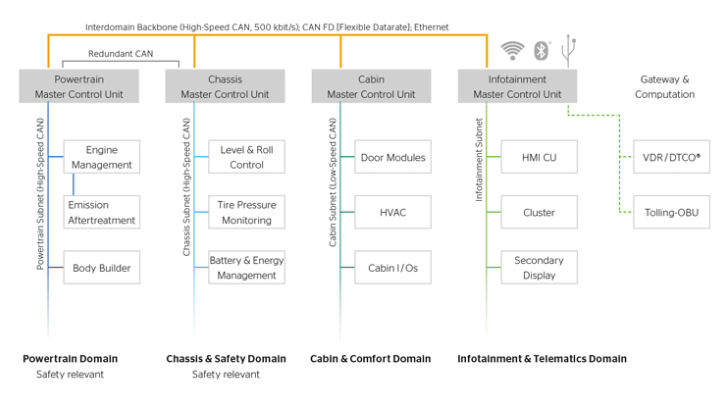As vehicle architectures continue to emerge, there is a desire to reduce the number of engine control unit (ECUs) in the vehicle and to organize functions into logical blocks. This is to not only reduce cost and complexity, but also to set the stage for future interoperability between major vehicle functional subsystems. Fig. 1 shows a typical domain controller network configuration.
 Figure 1: Example of a typical domain controller network
Figure 1: Example of a typical domain controller network
Upcoming IVI launches are following the domain controller architectural protocol. The cockpit domain is an extension of the IVI system, which includes:
- Traditional IVI functionality with the addition of:
- Higher resolution main display output (up to 8K)
- Connected services via integrated 4G and eventually 5G, including:
- Hybrid navigation
- Hybrid speech agents
- Streaming media
- Personalization
- IoT and mobility functions (parking, home integration etc.)
- Integration of additional display zones:
- Digital instrument cluster (720p)
- Auxiliary IP information display (up to 2x 4K)
- Heads-up display
- Intelligent rearview mirror
- Rear seat entertainment (2x 1080p)
- Additional cameras and image processing:
- Occupant detection and identification
- Drowsy driver monitoring
- Side mirror cameras
- Intelligent rearview camera (obstacle sensing)
- Surround view
- Additional HMI Interfaces
- Gesture
- Haptics
- Informational ADAS bridge to the ADAS environment
- AI for the management of driver/information interaction
With additional functionality comes an expanded hardware architecture and need for compute power, combined with vastly expanded display requirements. As of today, the functionality of the domain controller is still managed by a single SoC, albeit one of substantially higher compute power with expanded graphics. Low-level vehicle interface functions continue to be managed by a host MCU.
Typical hardware platform performance includes:
- Legacy IVI peripheral multimedia subsystems
- Up to 8 SoC cores (A57 equivalent up to 2.8 GHz)
- Expanded video processing (Up to 100MB/s)
- Up to 8 camera inputs 720P capture, HDR, H265 support
- Image recognition accelerators
- Wifi support for a/b/g/n/ac Wave 2 2.4/5/60 GHz
- Bluetooth 5.0
- NFC
- Software-defined radio
- Integrated modem up to Cat 24 5G
- USB 3.1/C
- AI and machine learning accelerators
Typical memory requirements are:
- Nonvolatile memory (64–256GB UFS or up to 512GB PCIe SSD in high-end systems)
- DRAM (up to 16GB density, 60–100 GB/s typically LPDDR4 -4267)
- Emerging opportunity for GDDR6
- Temperature requirements up to 115°C
- Extended cross-temperature requirements
- Emerging needs to qualify under ISO26262 standards as safety functionality is integrated to the domain controller
Part four of this blog series wraps things up with a virualization and security discussion around IVI.
Source: https://www.tuxera.com/a-brief-history-of-in-vehicle-infotainment-how-tuxera-fits-in/